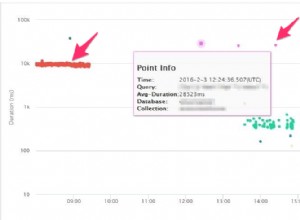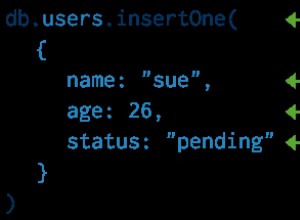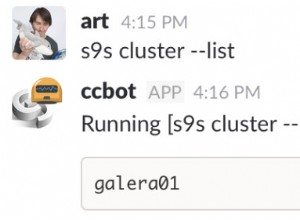L'impaginazione basata su cursore può essere implementata utilizzando qualsiasi campo della raccolta che sia Unico, Ordinabile e immutabile .
_id soddisfare tutti gli Unici, Ordinabili e Immutabili condizioni. Sulla base di questo campo possiamo ordinare e restituire il risultato della pagina con _id dell'ultimo documento come cusro per la successiva richiesta.
curl https://api.mixmax.com/items?limit=2
const items = db.items.find({}).sort({
_id: -1
}).limit(2);
const next = items[items.length - 1]._id
res.json({ items, next })
quando l'utente vuole ottenere la seconda pagina, passa il cursore (come successivo) sull'URL:curl https://api.mixmax.com/items?limit=2&next=590e9abd4abbf1165862d342
const items = db.items.find({
_id: { $lt: req.query.next }
}).sort({
_id: -1
}).limit(2);
const next = items[items.length - 1]._id
res.json({ items, next })
Se vogliamo restituire i risultati in un ordine diverso, come la data dell'articolo, aggiungeremo sort=launchDate alla querystring.curl https://api.mixmax.com/items?limit=2&sort=launchDate
const items = db.items.find({}).sort({
launchDate: -1
}).limit(2);
const next = items[items.length - 1].launchDate;
res.json({ items, next })
Per la richiesta di pagina successivacurl https://api.mixmax.com/items?limit=2&sort=launchDate&next=2017-09-11T00%3A44%3A54.036Z
const items = db.items.find({
launchDate: { $lt: req.query.next }
}).sort({
_id: -1
}).limit(2);
const next = items[items.length - 1].launchDate;
res.json({ items, next });
Se lanciassimo un mucchio di articoli nello stesso giorno e ora? Ora il nostro launchDate il campo non è più unico e non soddisfa Unico, Ordinabile e Immutabile . condizione. Non possiamo usarlo come campo cursore. Ma potremmo usare due campi per generare il cursore. Dal momento che sappiamo che il _id campo in MongoDB soddisfa sempre le tre condizioni precedenti, sappiamo che se lo usiamo insieme al nostro launchDate campo, la combinazione dei due campi soddisferebbe i requisiti e potrebbe essere utilizzata insieme come campo cursore.curl https://api.mixmax.com/items?limit=2&sort=launchDate
const items = db.items.find({}).sort({
launchDate: -1,
_id: -1 // secondary sort in case there are duplicate launchDate values
}).limit(2);
const lastItem = items[items.length - 1];
// The cursor is a concatenation of the two cursor fields, since both are needed to satisfy the requirements of being a cursor field
const next = `${lastItem.launchDate}_${lastItem._id}`;
res.json({ items, next });
Per la richiesta di pagina successivacurl https://api.mixmax.com/items?limit=2&sort=launchDate&next=2017-09-11T00%3A44%3A54.036Z_590e9abd4abbf1165862d342
const [nextLaunchDate, nextId] = req.query.next.split(‘_’);
const items = db.items.find({
$or: [{
launchDate: { $lt: nextLaunchDate }
}, {
// If the launchDate is an exact match, we need a tiebreaker, so we use the _id field from the cursor.
launchDate: nextLaunchDate,
_id: { $lt: nextId }
}]
}).sort({
_id: -1
}).limit(2);
const lastItem = items[items.length - 1];
// The cursor is a concatenation of the two cursor fields, since both are needed to satisfy the requirements of being a cursor field
const next = `${lastItem.launchDate}_${lastItem._id}`;
res.json({ items, next });
Riferimento:https://engineering.mixmax.com/ blog/api-paging-costruito-nel-modo-giusto/




